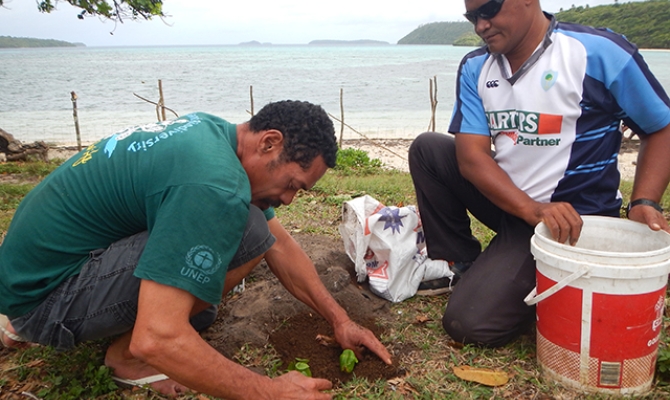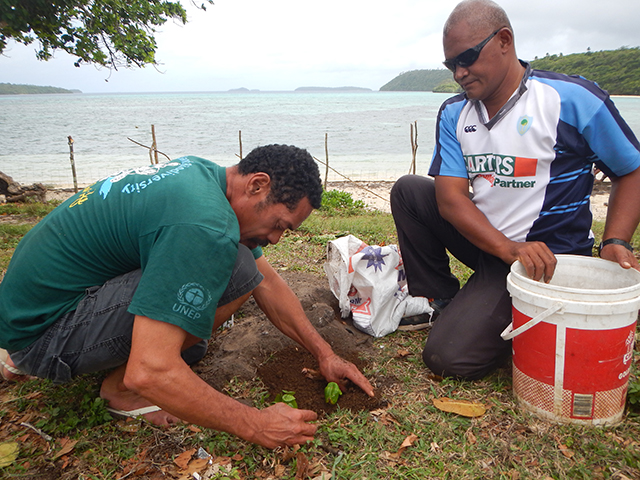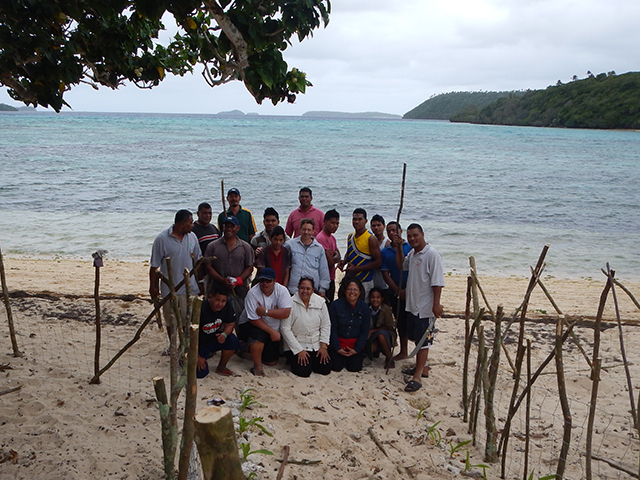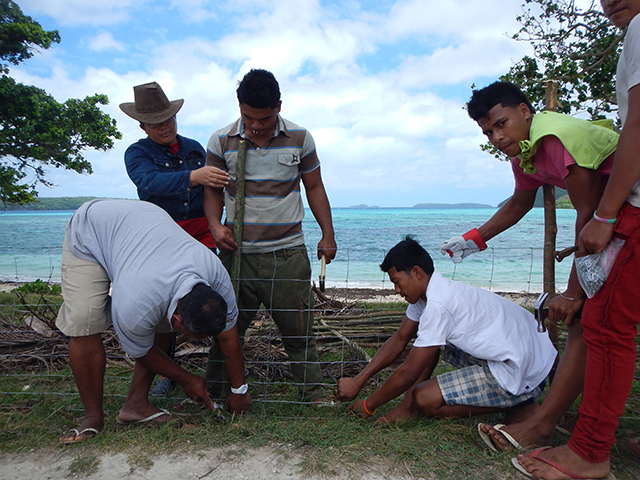
Island and Ocean Ecosystems
An innovative set of techniques developed specifically for the strengthening and rehabilitation of beaches in the Pacific island region have been put to the test in Vava'u, Tonga.
This approach to coastal erosion has been developed over the past two years as part of the coastal Ecosystem-based Adaptation project which is implemented by the Secretariat of the Pacific Regional Environment Programme (SPREP) and funded by the Australian Government under its International Climate Change Adaptation Initiative (ICCAI).
The beach rehabilitation guidelines and practical interventions - developed over the past two years and tested in Samoa, Vanuatu and Kiribati - are designed to limit and, where possible, stop continued erosion on affected beaches in the region and put in place strategies to try to reverse damage that has already taken place. Such rehabilitation can strengthen coastal resilience to the impacts associated with sea level rise.

Crucially, the techniques are designed to be cheap, achievable and easily managed by local communities in both the short and long term. Dr Joanna Ellison, an expert on coastal geomorphology from the University of Tasmania and a long-term collaborator with SPREP on coastal issues, helped to devise the techniques following extensive research and testing in North Tarawa, Kiribati. She explains:
"Everybody knows that erosion is a problem on a lot of Pacific island beaches, but what many people don't know is that there are many low cost, natural ways to make beaches stronger. Often, people put a lot of pressure on beaches without realising. By recognising and reducing this pressure we can work together to get sediment to come back to the beach and stay there."

The value and importance of community support was aptly demonstrated during the recent application of these tactics at Talihau Paradise Beach in Vava'u. Representatives from all levels of government joined forces with members of the community to protect the quite seriously degraded Talihau Paradise Beach from further erosion.
Town Officer, Siaosi, observed that in the 33 years he has lived at Talihau he has witnessed a large number of changes to the beach:
"Just ten years ago there were a lot of trees and the sea level was far away from the shoreline. Now you can see that things are very different. It is not only the natural activities that cause this erosion, but the human activities too."

SPREP's Environmental Monitoring and Reporting Officer, Mr Paul Anderson, said that an assessment of the beach confirmed Siaosi's suspicion that human impacts were having a grave effect on the condition of the beach. In the 100 metres long stretch of beach, Mr Anderson observed only six mature trees and no evidence of new growth - a classic sign of degradation caused by trampling from humans and animals. He explains:
"The good news is that there is a lot we can do to curb the harmful impact of humans and animals, and here in Talihau we've been able to implement a lot of them in a relatively short period of time. Some of the interventions we've put in place have included fencing to prevent livestock from damaging beachside vegetation, putting systems in place to prevent the mooring of boats on degraded areas of the beach and talking to the community about the damaging impact of sand mining."
Other interventions used in Talihau included the replanting of coastal vegetation and the creation of brush protection mats to try and build up the volume of sand on the beach. These measures will help to restore a healthy ecosystem to Talihau, making it more climate resilient and better able to bounce back from the impacts of severe weather patterns and natural disasters.
Mr Vainuupo Jungblut, SPREP's Ramsar Officer for Oceania explained that the creation and placement of the brush protection mats required a lot of manpower:
"It was really hard work but the great community effort and support made light work of it all. I take my hat off to the community of Talihau for their hard work, dedication and ownership of this initiative."
Ms 'Ana Finau, who lives in Talihau summed up the mood in the Talihau community with these words:
"I am happy now. This is like a dream come true to have something like this to help us to protect our beach. We are so happy to have this work as we know it's for the benefit of our community and for our grandkids in the future. We will work together and help each other by replanting trees, replacing the fence if it breaks and help to conserve the areas from being abused by animals and visitors."
For now, the enthusiastic community of Talihau will oversee the maintenance of the beach, with assistance from the Tongan Ministry of Environment and the Vava'u Environmental Protection Association (VEPA).
Over the coming months, SPREP will befunding work to protect further stretches of coastline at Talihau and will continue to work closely with the community on the monitoring of coastal erosion in the area.
This approach to coastal erosion has been developed over the past two years as part of the coastal Ecosystem-based Adaptation project which is implemented by the Secretariat of the Pacific Regional Environment Programme (SPREP) and funded by the Australian Government under its International Climate Change Adaptation Initiative (ICCAI).
The beach rehabilitation guidelines and practical interventions - developed over the past two years and tested in Samoa, Vanuatu and Kiribati - are designed to limit and, where possible, stop continued erosion on affected beaches in the region and put in place strategies to try to reverse damage that has already taken place. Such rehabilitation can strengthen coastal resilience to the impacts associated with sea level rise.

An important part of beach rehabilitation is replanting vegetation to try to prevent further erosion. Photo: Paul Anderson/SPREP
Crucially, the techniques are designed to be cheap, achievable and easily managed by local communities in both the short and long term. Dr Joanna Ellison, an expert on coastal geomorphology from the University of Tasmania and a long-term collaborator with SPREP on coastal issues, helped to devise the techniques following extensive research and testing in North Tarawa, Kiribati. She explains:
"Everybody knows that erosion is a problem on a lot of Pacific island beaches, but what many people don't know is that there are many low cost, natural ways to make beaches stronger. Often, people put a lot of pressure on beaches without realising. By recognising and reducing this pressure we can work together to get sediment to come back to the beach and stay there."

A pathway to Talihau Paradise Beach was constructed in an effort to minimise foot traffic on vulnerable parts of the beach. Photo: Paul Anderson/SPREP
The value and importance of community support was aptly demonstrated during the recent application of these tactics at Talihau Paradise Beach in Vava'u. Representatives from all levels of government joined forces with members of the community to protect the quite seriously degraded Talihau Paradise Beach from further erosion.
Town Officer, Siaosi, observed that in the 33 years he has lived at Talihau he has witnessed a large number of changes to the beach:
"Just ten years ago there were a lot of trees and the sea level was far away from the shoreline. Now you can see that things are very different. It is not only the natural activities that cause this erosion, but the human activities too."

Fences were constructed at Talihau to keep pigs and cows from trampling beach vegetation. Photo: Paul Anderson/SPREP
SPREP's Environmental Monitoring and Reporting Officer, Mr Paul Anderson, said that an assessment of the beach confirmed Siaosi's suspicion that human impacts were having a grave effect on the condition of the beach. In the 100 metres long stretch of beach, Mr Anderson observed only six mature trees and no evidence of new growth - a classic sign of degradation caused by trampling from humans and animals. He explains:
"The good news is that there is a lot we can do to curb the harmful impact of humans and animals, and here in Talihau we've been able to implement a lot of them in a relatively short period of time. Some of the interventions we've put in place have included fencing to prevent livestock from damaging beachside vegetation, putting systems in place to prevent the mooring of boats on degraded areas of the beach and talking to the community about the damaging impact of sand mining."
Other interventions used in Talihau included the replanting of coastal vegetation and the creation of brush protection mats to try and build up the volume of sand on the beach. These measures will help to restore a healthy ecosystem to Talihau, making it more climate resilient and better able to bounce back from the impacts of severe weather patterns and natural disasters.
Mr Vainuupo Jungblut, SPREP's Ramsar Officer for Oceania explained that the creation and placement of the brush protection mats required a lot of manpower:
"It was really hard work but the great community effort and support made light work of it all. I take my hat off to the community of Talihau for their hard work, dedication and ownership of this initiative."
Ms 'Ana Finau, who lives in Talihau summed up the mood in the Talihau community with these words:
"I am happy now. This is like a dream come true to have something like this to help us to protect our beach. We are so happy to have this work as we know it's for the benefit of our community and for our grandkids in the future. We will work together and help each other by replanting trees, replacing the fence if it breaks and help to conserve the areas from being abused by animals and visitors."
For now, the enthusiastic community of Talihau will oversee the maintenance of the beach, with assistance from the Tongan Ministry of Environment and the Vava'u Environmental Protection Association (VEPA).
Over the coming months, SPREP will befunding work to protect further stretches of coastline at Talihau and will continue to work closely with the community on the monitoring of coastal erosion in the area.